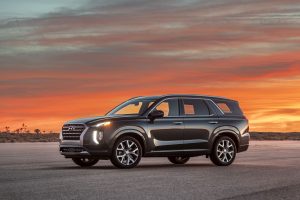AN IMPRESSIVE PACKAGE, WITH QUALITY MATERIALS, ASSEMBLY AND A COMFY RIDE. JUST GOTTA GET USED TO THAT GRILLE.
On paper, it's forgivable to have your doubts about the new 2020 Palisade, until recently Hyundai's latest effort in their proliferating lineup of SUVs (the new subcompact Venue is the latest). I know I did. You see, the Hyundai Palisade shouldn't be as good as it is.

But even then, Hyundai was the undisputed heavyweight champion of the world when value for the money was in question. It's a trend that continues to this very day.
That value, though, used to be solely on a cost basis. When Hyundai entered the US market in 1984, it took the position previously held by the then- increasingly-premium Japanese automakers: exceptional value via rock bottom pricing and fuel efficiency. But one major detail was lacking: quality - in both construction of the car itself and dependability over the long run. Unlike Toyotas, early Hyundais broke. Sometimes pieces of the car could come right off in your hand.
Yet over the past decade or so, if Hyundai has proven anything, it's that none of those foggy memories should worry you much at all. The company's latest automotive efforts are so polished and well-executed (and we include sister company Kia in this) that they're impossible to ignore. And the large-midsize, three-row Palisade fits this trend to a tee. This vehicle, and its sibling, the Kia Telluride, are so good, in fact, that they're probably the top two choices in the entire class - which is nothing to sneeze at, since it includes the fun-to-drive Mazda CX-9, new Subaru Ascent, new 2020 Ford Explorer and the VW Atlas as competition.
The Palisade is built on a traditional steel unibody with selective sections of High-Strength Steel for robust crash energy absorption. It includes front-wheel-drive as standard across all trim levels, with HTRAC AWD as a $1700 option.
How does it drive? Quite comfortably, thank you. It has a plush, pothole-absorbing ride, rigid structure and extensive sound deadening insulation under the hood and over the firewall. Thanks to its 291-hp, 3.8L V6, the Palisade can step out with some authority, though it's no drag racer; 0-60 should wind up somewhere in the mid 7-second range. Its 8-speed auto, when hooked up to an application like this (versus the Stinger GT/GTS, for example), provides seamless gear-changing, though it moves to up-shift quickly for increased efficiency in most applications. Its Telluride platform-mate has sportier transmission software tuning.
In the corners, the Palisade will follow even your more aggressive commands but makes clear it doesn't exactly enjoy being hustled. On the hilly, winding and undulating roads above Malibu, California, our Palisade Limited exhibited some tire squeal when hustled around tight bends, but then again it's a big rig - almost full-sized dimension-wise - and will stay planted even on pavement with rapidly changing incline/decline. All in all, it feel safe and secure rather than enthusiastic and sporty. That's OK; again, the Telluride is the sportier-driving choice here, and the Hyundai the slightly cushier, more plush one
To wit, experiencing the Palisade will only reinforce the notion that Hyundai still does value quite well. It includes an-almost exhaustive list of standard features on even the base trim cars, including Apple CarPlay/Android Auto, seating for 8, Forward Collision Avoidance Assist w/ Pedestrian Detection; Lane Keeping Assist, and more. And at about $44K to start, the Palisade Limited we tested comes standard with a whole host of upscale features and only one option: a 291hp V6 (standard on all trims of Palisade) coupled to H/K’s in-house 8-speed automatic; 8-way powered driver’s seat; dual moonroofs; button-based climate control and major stereo functions; push-button drive select; semi-quilted Napa leather; Head Up Display; 12.3” digital gauge cluster; Apple CarPlay/Android Auto; and more. The sole option? HTRAC AWD. The infotainment system is fast to respond and intuitive to use, with much-improved graphics over the Kia Stinger we just tested. It's clear that the Koreans just keep learning and iterating, getting a little bit better with each effort. All with a long-term view toward market share growth, which has followed along predictably.
But what Hyundai has changed since the mid-80s is pretty big: the build quality of our production Palisade Limited was phenomenal, with nary a mismatched panel or panel gap issues whatsoever, a beautifully-finished interior with super-soft Napa leather, soft-touch plastics all around, a smart "floating" center console for more up-front storage space, and commanding, if not exactly beautiful, looks. They've notably moved up quite a bit in JD Power Initial Quality Studies, with the mid-size Santa Fe SUV taking top honors in Initial Quality for 2019. A slew of Hyundai, Kia and Genesis models litter the top IQ picks this year alone.
The Palisade is produced at Hyundai's Ulsan, Korea factory, while the Telluride is made at Kia's West Point, Georgia (USA) plant.
In all, it's quite simple: if you're looking at larger mid-sized, three-row SUVs, the Palisade should be at the top of your list.
-BD